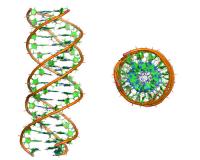
This is a simulation of a triple DNA helix structure side view and viewed from above. A team of researchers at the Institute for Research in Biomedicine (IRB Barcelona) and the Barcelona Supercomputing Center (BSC) have managed for the first time to extract trustworthy structural information from a triple helix DNA in gas phase, that is to say in conditions in which DNA is practically in a vacuum. The study appears today in the Journal of the American Chemical Society (JACS), one of the journals with greatest impact in chemistry.
"Until now these special DNA structures were almost impossible to detect and it was not known whether they preserved structural memory in solution when they were evaporated. With this study we have characterized this structure and demonstrated that it maintains a surprising memory of its previous biological environment, aqueous solution, in which it is normally very difficult to characterize", explains Modesto Orozco, principal investigator at IRB Barcelona, senior professor at the University of Barcelona and director of Life Sciences at the BSC. Orozco's team has combined computational simulation techniques with experimental validation through mass spectrometry. This was the last structure pending to complete the atlas of classical DNA structures in gas phase, work that has taken Dr. Orozco's group more than ten years of dedication.
A step towards antigen therapy
One of the most relevant biomedical consequences of this study is that it could avail the development of the so-called antigen therapy. This therapeutic approach, which is based on DNA triple helix structures, would switch off the activity of the genes involved in a given disease. "There is still no drug based on gene therapy in the market but several are under development", explains the researcher. One of the main obstacles blocking the availability of these therapies was in the difficulty to experimentally detect these triple helix structures. "Demonstration that the structure is maintained in gas phase will allow these DNA structures to be detected more easily", affirms Dr. Orozco.
Shedding light on biological molecules
Furthermore, these results pave the way for the implementation of new structural resolution techniques based on the use of x-ray free-electron lasers (X-FEL). The X-FEL is a large scientific facility being built in Germany that produces intense light pulses, similar to a synchrotron. "If our calculations are correct X-FEL could be used to obtain structural data in gas phase about the behavior of a molecule in its natural biological environment and X-FEL would become a very powerful tool to resolve the structure of macromolecules", Orozco goes on to say.
Computational simulation has been performed using the supercomputer MareNostrum at the BSC while the experimental validation has been undertaken by the Mass Spectrometry Core Facility at IRB Barcelona, the Experimental Bioinformatics Lab (EBL) –a joint IRB Barcelona and BSC facility-, and with the collaboration of Valerie Gabelica's group at the University of Liège, Belgium.
Source : Institute for Research in Biomedicine (IRB Barcelona)
 Print Article
Print Article Mail to a Friend
Mail to a Friend
